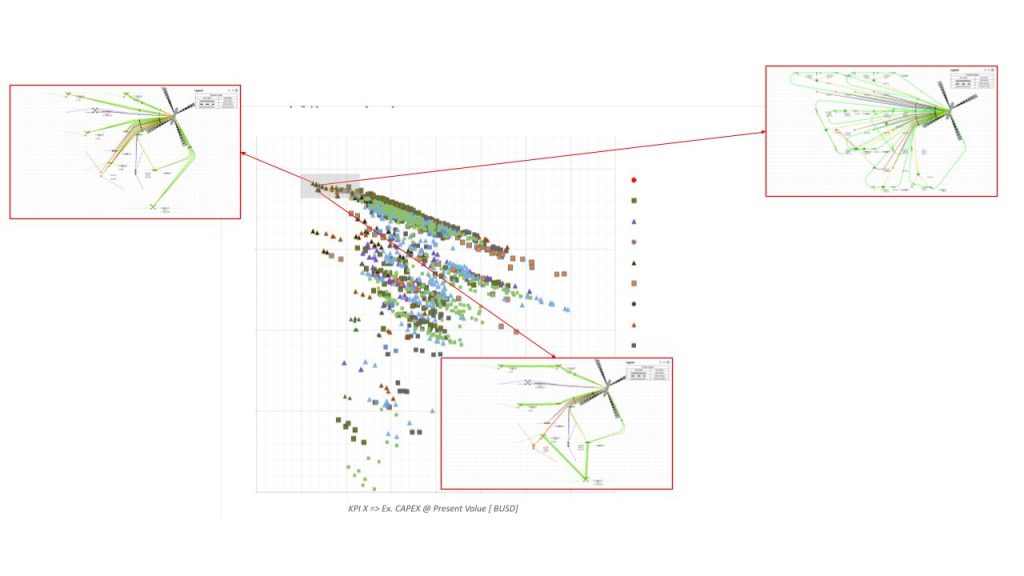Generating subsea layout combinations is the main objective of Subsea discipline in FLOCO®. In the Subsea tab, boundary conditions for layout generation are inserted. It is possible to define which type of subsea archetype will be considered in the simulation for layout generation.
FLOCO® has four types of archetypes: satellite, manifold (isolated and daisy chain), loop and trunkline. For each type of functional system (production, gas injection, water injection and WAG) it is possible to select which will be the archetype. For the manifold option, it is possible to define which type of gathering line will be used as Rigid Spool or Flexible Jumper, in addition to the minimum and maximum lengths for one of them. The same is possible for loop and trunkline, however it is also possible to choose the group of wells that will have this configuration.
The riser types and their configuration can be defined. The options are steel catenary riser, flexible catenary riser, steel lazy wave riser and flexible lazy wave riser. For the catenaries it is possible to define the output angle of the production unit and for lazy waves the angle of sag and hog.
To add constraint to production unit selection, metocean conditions are important. There are seven types of production facility available on FLOCO®. Among them four are floating (FPSO Spread, FPSO Turret, Semisubmersible and TLP) and three are fixed (Jacket, Compliant Tower and GBS).
It is possible to add constraints to flowlines such as ID, thermal insulation, and radio bending.
For control and service of subsea equipment, there is a tab where it is possible to define them for each functional system type and layout archetype, for example we have the options service & umbilical, integrated umbilical, and umbilical alone.
The selection of materials can be automatic, considering technical requirements for each line, or individualized where the user defines it.
In the subsea discipline it is also possible to generate concepts with subsea processing. The user can add pumps, separators and seawater injection, as well as being able to combine them.
With the constraint information and subsea definitions inserted, FLOCO® generates hundreds or thousands of possible layouts for the field being analyzed using metaheuristic and optimization algorithms. Once the layouts are generated, it is possible to navigate through the elements and their properties, such as line length, equipment location, among others.
The FLOCO4Brownfield options are also found in subsea, which are divided into three main areas: manual modelling, life extension and decommissioning. In manual modelling, the user can either start a new concept or edit an existing concept from an intuitive and easy-to-use interface.
The life extension analyses allow the user to understand what the magnitude of the required investment would be based on a multicriteria analysis that considers the degradation rate of the field based on the lifecycle of the field, condition of the equipment and maintenance data.
In decommissioning, reports are generated on the costs of removing, cleaning, and abandoning elements of an offshore oil field. By associating the complexity of the operation with the necessary infrastructure such as boats and equipment, it is possible to generate decommissioning analyses.
At the end, multiple reports are generated as deliverables (Material Take-off, Construction, and Finance) that support the project team’s decision making.
Study presented in a Paper
In a presentation of paper SPE 210288 at the 2022 SPE Annual Technical Conference and Exhibition (ATCE), ExxonMobil evaluated an approach using FLOCO® (Field Lay Out Concept Optimizer) to generate and evaluate offshore engineering design concepts faster, looking for identifying the highest-value design concept.
The paper described how a computer created 120 conceptual alternatives within weeks based on different inputs for five variables and predicted their associated NPV (Net Present Value) and Capex (Capital Expenditure) considering lower and higher production estimates.

After FLOCO® finalized the simulation and the best concepts in terms of Capex and NPV were ranked, the advantageous options stood out. It became evident the huge difference between the best and the worst design concepts.
For the hypothetical field simulation, subsurface and production data estimations were provided by the company. To account for the production forecast uncertainties two production scenarios were considered for each design concept: one 20% higher and the other 10% lower.
Among the top designs, the best five were selected for both higher and lower oil production. And among the five variables considered, the one that impacted most the NPV was the pipe diameter.
The larger diameter pipes concepts benefit from the higher production at the beginning of the field life and for some time over the project life even though later the production would be lower than the smaller diameter pipe – several discussions and analysis could arise from that.
The conclusion was that the value relied on having a lot of options to consider and thus do a detailed investigation upfront.